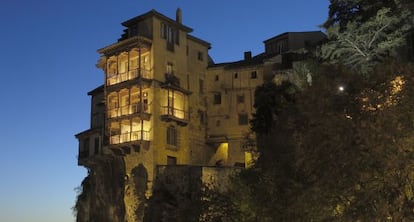Cuenca’s abstract art museum to mark 50th year with new extension
Gallery situated in city’s picturesque Hanging Houses to create more space to show works

It is one of the most picturesque museums in Spain, with one of the country’s most important collections of contemporary art. The Museum of Spanish Abstract Art located in Cuenca’s emblematic Hanging Houses turns 50 next year, and will celebrate by extending its exhibition space.
Speaking at a press conference on April 30, Javier Gomá, the director of the Juan March Foundation, which is responsible for the museum, described it as one of the most beautiful in the world, and now as irrevocably associated with Spanish abstract art as Paris’s Musée de Orsay is with Impressionism
The new space, which will add 100 square meters to the museum, is expected to open before summer 2016
He said the museum is to annex the building next door, allowing it to increase the number of works on show. The remodeling work would not interfere with the daily running of the museum, which will remain open throughout, he added.
The new space, which will increase the museum’s existing 170 square meters by a further 100, is expected to open before the summer of 2016. The work will cost around €300,000, which will be paid for by the Juan March Foundation.
In the abstract
- Located in the historic city of Cuenca, in central-eastern Spain, the Museum of Spanish Abstract Art has a permanent collection of 129 paintings and sculptures by the generation of abstract Spanish artists who emerged in the 1950s and 60s, including Manolo Millares, Antoni Tàpies, Eusebio Sempere and Antonio Saura, as well as others from the 1980s and 90s.
- In 1980, the founder of the museum, Fernando Zóbel, donated its collection to the Juan March Foundation, which incorporated the works into its own collection.
- Situated in the Casas Colgadas (Hanging Houses), in a late-15th-century medieval building, the museum has undergone various renovations over the years and, in 1994, opened its temporary exhibition galleries.
Cuenca Mayor Juan Ávila used the press conference to draw attention to the Espacio Torner, the city’s other major arts space, which has been closed for the last four years.
Located in the former church of San Pablo, it houses around 40 works by Gustavo Torner, one of the founders of the so-called Cuenca school of modern art that emerged in the 1950s.
“This city owes Torner a lot,” he said. “He is a huge artist, and it is in part thanks to him that the Museum of Spanish Abstract Art is located here.
“The Espacio Torner needs to reopen, but the town hall doesn’t have the money to do so alone. The central and regional governments have to provide help and contribute to the consortium created when Cuenca was declared a UNESCO World Heritage Site.”
Tu suscripción se está usando en otro dispositivo
¿Quieres añadir otro usuario a tu suscripción?
Si continúas leyendo en este dispositivo, no se podrá leer en el otro.
FlechaTu suscripción se está usando en otro dispositivo y solo puedes acceder a EL PAÍS desde un dispositivo a la vez.
Si quieres compartir tu cuenta, cambia tu suscripción a la modalidad Premium, así podrás añadir otro usuario. Cada uno accederá con su propia cuenta de email, lo que os permitirá personalizar vuestra experiencia en EL PAÍS.
¿Tienes una suscripción de empresa? Accede aquí para contratar más cuentas.
En el caso de no saber quién está usando tu cuenta, te recomendamos cambiar tu contraseña aquí.
Si decides continuar compartiendo tu cuenta, este mensaje se mostrará en tu dispositivo y en el de la otra persona que está usando tu cuenta de forma indefinida, afectando a tu experiencia de lectura. Puedes consultar aquí los términos y condiciones de la suscripción digital.
Últimas noticias
Most viewed
- Pablo Escobar’s hippos: A serious environmental problem, 40 years on
- Reinhard Genzel, Nobel laureate in physics: ‘One-minute videos will never give you the truth’
- Why we lost the habit of sleeping in two segments and how that changed our sense of time
- Charles Dubouloz, mountaineering star, retires at 36 with a farewell tour inspired by Walter Bonatti
- The Florida Keys tourist paradise is besieged by immigration agents: ‘We’ve never seen anything like this’








































